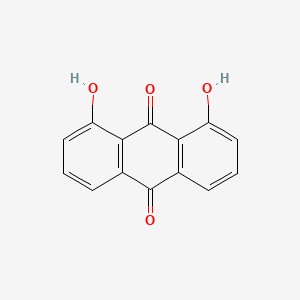Compound
D0864 | danthron
| Toxicity | Dose | Time | Species | Model | Method | Action | Positive criterion | Reference |
|---|---|---|---|---|---|---|---|---|
| MEMBRANE POTENTIAL | 4.66±1.19 | human | qHTS-HepG2 | MMP assay | decrease | IC50 | 163 | |
| MEMBRANE POTENTIAL | 15.45 | human | HepG2 | MMP assay | decrease | IC50 | 163 | |
| MEMBRANE POTENTIAL | 5.97±5.35 | rat | hepatocytes | MMP assay | decrease | IC50 | 163 | |
| Pictogram | Signal | Statements | Precautionary Statement Codes |
|---|---|---|---|
 |
Warning |
Aggregated GHS information provided by 49 companies from 4 notifications to the ECHA C&L Inventory. H351 (95.92%): Suspected of causing cancer [Warning Carcinogenicity] Information may vary between notifications depending on impurities, additives, and other factors. The percentage value in parenthesis indicates the notified classification ratio from companies that provide hazard codes. Only hazard codes with percentage values above 10% are shown. |
P201, P202, P281, P308+P313, P405, and P501; (The corresponding statement to each P-code can be found at the GHS Classification page.) |
 |
Danger |
H350: May cause cancer [Danger Carcinogenicity] |
P201, P202, P281, P308+P313, P405, and P501; (The corresponding statement to each P-code can be found at the GHS Classification page.) |
 |
Warning |
H351: Suspected of causing cancer [Warning Carcinogenicity] |
P201, P202, P281, P308+P313, P405, and P501; (The corresponding statement to each P-code can be found at the GHS Classification page.) |
| Organism | Test type | Route | Dose (normalized dose) | Effect | Source |
|---|---|---|---|---|---|
| mouse | LD50 | intravenous | > 10gm/kg (10000mg/kg) | Pharmacology and Toxicology Vol. 61, Pg. 153, 1987. | |
| mouse | LD50 | oral | > 7gm/kg (7000mg/kg) | Drug and Chemical Toxicology. Vol. 1, Pg. 89, 1977/1978. | |
| rat | LD50 | intraperitoneal | 1110mg/kg (1110mg/kg) | Gigiena i Sanitariya. For English translation, see HYSAAV. Vol. 52(12), Pg. 93, 1987. | |
| mouse | LD50 | intraperitoneal | 500mg/kg (500mg/kg) | National Technical Information Service. Vol. AD277-689, | |
| 1,10-Anthracenedione, 8,9-dihydroxy- | 1,4,5,8-Tetroxyantraquinone | 1,8 Dihydroxy Anthraquinone |
| 1,8-Dihydroanthraquinone | 1,8-Dihydroxy-9,10-anthracenedione | 1,8-Dihydroxy-9,10-anthracenedione, 9CI |
| 1,8-Dihydroxy-9,10-anthraquinone | 1,8-Dihydroxyanthra-9,10-quinone | 1,8-Dihydroxyanthra-9,10-quinone # |
| 1,8-Dihydroxyanthracene-9,10-dione | 1,8-Dihydroxyanthracene-9,10-dione (Danthron) | 1,8-Dihydroxyanthrachinon |
| 1,8-Dihydroxyanthrachinon [Czech] | 1,8-Dihydroxyanthraquinone | 1,8-Dihydroxyanthraquinone ,(S) |
| 1,8-Dihydroxyanthraquinone, 95% | 1,8-Dihydroxyanthraquinone, 96% | 1,8-Dihydroxyanthraquinone, Vetec(TM) reagent grade, 96% |
| 1,8-bis(oxidanyl)anthracene-9,10-dione | 1,8-dihydroxy-9,10-dihydroanthracene-9,10-dione | 1,8-dihydroxy-anthraquinone |
| 1,8-dioxyanthraquinone | 117-10-2 | 140861-59-2 |
| 3nsq | 8,9-dihydroxy-1,10-anthraquinone | 9, 1,8-dihydroxy- |
| 9,10-Anthracenedione, 1,8-dihydroxy- | A803710 | AB00051961_09 |
| AB1006759 | ACMC-20mzuc | ACon1_000135 |
| AI3-38117 | AK208660 | AKOS001583216 |
| ANW-17004 | ARONIS23892 | Altan |
| Anthraquinone, 1,8-dihydroxy- | Anthraquinone,8-dihydroxy- | Anthraquinone-related compound |
| Antrapurol | BBC/171 | BBL013161 |
| BCP31079 | BDBM11316 | BRD-K10065684-001-02-5 |
| BRD-K10065684-001-03-3 | BRD-K10065684-001-06-6 | BSPBio_002259 |
| Bancon | C10312 | CAS-117-10-2 |
| CCG-35470 | CCRIS 3529 | CHEBI:3682 |
| CHEMBL53418 | CS-4392 | CTK0F1106 |
| CTK3J0719 | Chrysazin | Chrysazin;1,8-Dihydroxyanthraquinone;1,4,5,8-tetroxyantraquinone |
| Chrysazine | Chrysazine | Criasazin |
| D0563 | D07107 | DB04816 |
| DSSTox_CID_328 | DSSTox_GSID_20328 | DSSTox_RID_75516 |
| DTXSID9020328 | Danivac | Danthron |
| Danthron (1,8-Dihydroxyanthracene-9,10-dione) | Danthron [BAN] | Danthron [USP] |
| Danthron, BAN | Dantron | Dantron |
| Dantron (Chrysazin | Dantron (INN) | Dantron [INN] |
| Dantron, INN | Dantrona | Dantrona [INN-Spanish] |
| Dantrone | Dantrone [INN-French] | Dantronum |
| Dantronum [INN-Latin] | Diaquone | Dionone |
| Dioxyanthrachinonum | DivK1c_000284 | Dorbane |
| Dorbanex | Dorbanex (Salt/Mix) | Dorbantyl (Salt/Mix) |
| Duolax | EINECS 204-173-5 | EU-0099935 |
| FT-0624445 | HMS2091A09 | HMS3715F08 |
| HMS500O06 | HS-1003 | HSDB 7764 |
| HY-B0923 | IDI1_000284 | InChI=1/C14H8O4/c15-9-5-1-3-7-11(9)14(18)12-8(13(7)17)4-2-6-10(12)16/h1-6,15-16; |
| Istan | Istizin | Istizine |
| KBio1_000284 | KBio2_002230 | KBio2_004798 |
| KBio2_007366 | KBio3_001479 | KBioGR_001944 |
| KBioSS_002230 | KS-00000W95 | KSC490O1T |
| LS-587 | LTAN | Laxanorm |
| Laxanthreen | Laxapur | Laxipur |
| Laxipurin | MCULE-5800615690 | MEGxp0_001693 |
| MFCD00001211 | MLS000069608 | Modane |
| NCGC00091367-01 | NCGC00091367-02 | NCGC00091367-03 |
| NCGC00091367-04 | NCGC00091367-05 | NCGC00091367-06 |
| NCGC00091367-07 | NCGC00258539-01 | NCI60_041443 |
| NCIMech_000114 | NINDS_000284 | NSC 38626 |
| NSC 646568 | NSC-38626 | NSC-646568 |
| NSC-7210 | NSC-755828 | NSC38626 |
| NSC646568 | NSC7210 | NSC755828 |
| Neokutin S | OR61434 | Pastomin |
| Pharmakon1600-00211468 | Pilules Vinchy N.F. (TN) | Prugol |
| Q5221244 | QBPFLULOKWLNNW-UHFFFAOYSA-N | R229 |
| RTR-003068 | Roydan | SBB057973 |
| SBI-0051330.P003 | SCHEMBL83688 | SMR000059018 |
| SPBio_000506 | SPECTRUM211468 | SR-01000721864 |
| SR-01000721864-2 | ST50330603 | STK238373 |
| SY011288 | Scatron D | Spectrum2_000603 |
| Spectrum3_000650 | Spectrum4_001682 | Spectrum5_000324 |
| Spectrum_001750 | TR-003068 | Tox21_111122 |
| Tox21_111122_1 | Tox21_200986 | UNII-Z4XE6IBF3V |
| Usaf nd-59 | W-108572 | WLN: L C666 BV IVJ DQ NQ |
| Z4XE6IBF3V | ZINC3860369 | ZX-AS004388 |
| ZX-AT013456 | Zwitsalax | component of Dorbantyl |
| component of Doxan | component of Doxidan | component of Modane |
| danthro-lax | danthron | danthrone |
| dianthon | dihyanthraquin_P21/n_LT | dihyanthraquin_P41212_RT |
| dihyanthraquin_P41_LT | dihyanthraquin_P41_LT-Polymorph5 | dihyanthraquin_P41_RT-Polymorph1 |
| dihydroxyanthraquino ne | s4561 |

